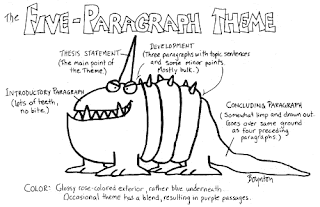I don’t really
watch too many movies, so I’m having a hard time coming up with some favorite
endings. But, I think the ending of The Squid and the Whale was pretty good. It didn't sugar coat anything while still giving us a bit of resolution between characters, as Walt spends some time with the squid and the whale, which, in a way, represented his relationship with his mother when he was young.
I'm a bit more familiar with books.
Hemingway’s The Sun Also Rises has one of the best
endings. The whole book is about a disillusioned group of young people that are
struggling to find their own purpose after the war. The very last line of the
book is, “Isn’t it pretty to think so?”, which perfectly sums up all the
apathy, indifference, and disillusionment that causes the characters so much
pain throughout the novel.
 |
| So many Hemingways |
Hamlet has another great ending. While
we of course know that a bunch of people are going to die at the end, by
closing with Fortinbras overtaking as ruler, it’s as though the story has come
full circle with a new leader (like Hamlet’s uncle at the beginning), even
though we aren’t exactly sure it will be less corrupt than the previous
kingdom.
 |
| Fortinbras, ready to rule |
A Farewell to Arms by Hemingway also
ends tragically but perfectly. With (sorry, spoiler alert) both the main
character Lieutenant Henry’s wife and child dying at the end, I think these
awful events really represent just how painful life can be, especially in relation
to the rest of the events in the novel such as the war and the injuries
experienced by Henry.
 |
| Lego Hemingway? |
I think some of
the best endings are unpredictable and often not happy and perfect, because
these more realistic endings allow you to connect more emotionally to the story
overall, and keeps you thinking about the novel. I think the ending of A Temporary Matter has this realistic sadness to it, as the couple
realizes that as they shared their secrets and became more open with each
other, they were, in fact, distancing themselves more. Mrs. Sen’s also ends
similarly, as Eliot and Mrs. Sen stop looking after each other and go back to
what was ‘normal,’ although both are unhappy. The ending of This Blessed House also seems like there
is not quite any resolution between the characters, as Sanjeev just ends up
following Twinkle around the house searching for more leftover religious
paraphernalia. However, all of these endings are real, allowing us to relate to the characters and the events in the
stories even better, and therefore allowing us to learn more from them.
 |
| Not to be confused with The Emperor of all Maladies |
Essentially, this
is what the best endings do: by bringing the story back together, they teach us,
about ourselves, our relationships, and our environment. And, this is what I want to do in my own
story. While I’m still searching for a way to realistically and memorably link
the events of the story back together, I want to be sure to use my story to
teach others about the lost, the found, and our relationship to that.











